Observing Crow ‘Funerals' And Plenty Of Lively Crow Life
Crow thanatology isn't a bummer for researcher Kaeli Swift "that's because the Cheeto-munching, sunbathing birds make sure of it.
By Vicki Croke

In the crow-dense metro-area of Seattle, and beyond, Swift does a lot of crow watching. Photo: Kaeli Swift.
Kaeli Swift's specialty is, as she defines it, the thanatology of crows. Basically, she puzzles out the meaning of "crow funerals" "observing and documenting the extraordinary behavior of ordinary American crows who often call to one another and gather together when they become aware of the presence of another dead crow. In doing so, crows join an elite circle of intelligent, social creatures, including dolphins, non-human primates, elephants, and other birds in the corvid family, such as western scrub jays, who, scientists say, respond "strongly" to the presence of dead members of their own species.
Scientifically speaking, much has yet to be puzzled out. Toward that end, in order to better understand "at least with crows " how and why this happens, Swift, a PhD candidate at the School of Environmental and Forest Sciences at the University of Washington, does a lot of fieldwork. Under the guidance of famed crow expert John Marzluff, Swift and her volunteers have conducted a number of experiments.
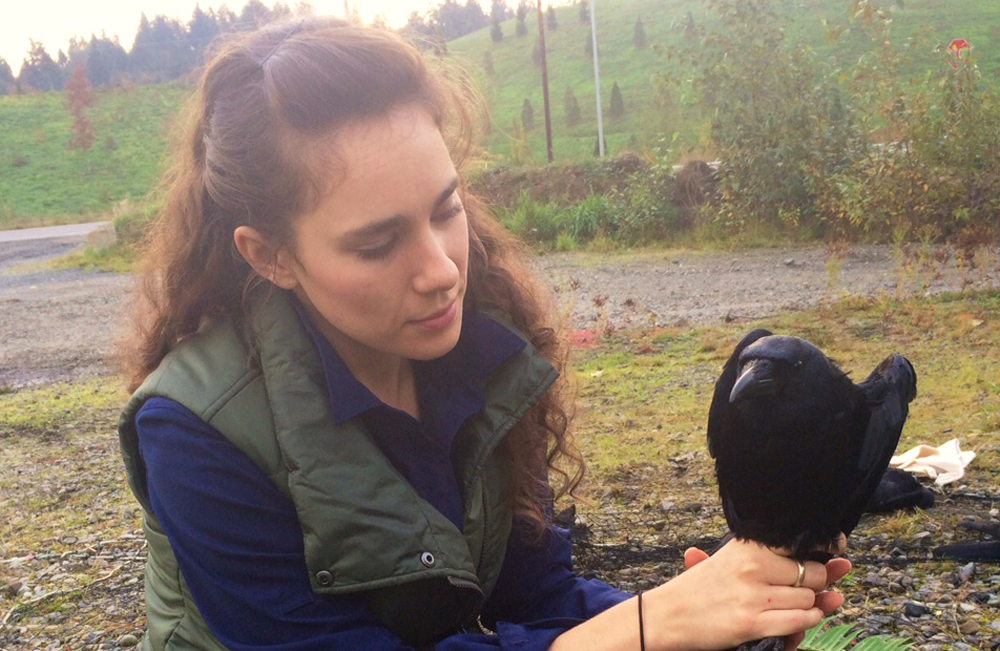
"Studies that provide bridges from humans to other animals are critical to fostering a culture that respects and protects the natural world," writes Kaeli Swift, "and this is one of the reasons I most enjoy working with crows." Photo: Kaeli Swift.
A well known one involved feeding crows around the city of Seattle (that was to draw the birds in on a regular basis); devising a few variables; having volunteers wear latex masks while holding dead (taxidermied) crows (crows recognize faces, and realistic latex masks were used); and then observing the reactions of the crows to both the lifeless crow and the masked person holding it.
Whatever else might be going on with the birds (are they mourning?), it does appear that by gathering around a dead crow, living crows are learning about possible dangers. Hence, the title of the paper authored by Swift and Marzluff, "Wild American crows gather around their dead to learn about danger," which appeared in the journal "Animal Behaviour" in 2015. That paper was not the end of the crow funeral business for Swift who continues to probe this behavioral phenomenon. In fact, she says, her latest field research (the details are a secret!) is looking more deeply at the possible contextual nuances of this funeral behavior.
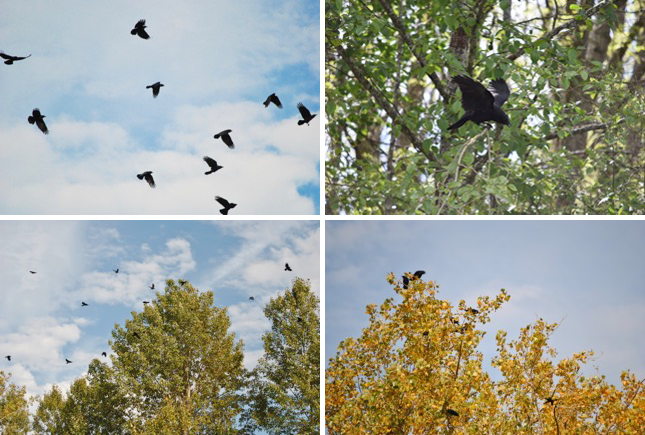
Gathering, alarm calling, scolding "a few of the behaviors Kaeli Swift has observed in her crow "funeral" experiments. Photo: Kaeli Swift.
Although Swift's work may sound morbid, it often turns out to be the opposite. That's because as she spends her time staging and attending crow funerals, she also ends up observing an awful lot of exuberant crow life.
The notion may seem paradoxical (lots of interesting things do, don't they?), but it actually makes sense. As Swift says on her Corvid Research blog, she spends her "days wandering the neighborhoods of Seattle" in pursuit of crow families to learn from. "Since I need lots of data points it means I encounter lots (think hundreds) of individual crows."
Hundreds of crows? Yes, in the crow-dense metro-area of Seattle, and beyond, Swift does a lot of crow watching. So, perhaps not as much in her scientific papers, but most definitely in conversation, on social media, and on her inquisitive, funny blog, Kaeli Swift's adventures with, and observations about crows are bursting with warmth and life.
Check out our story and on-air Here&Now reporting on crow intelligence: "How Smart Are Crows? Scary Smart."
Take, for instance, the female crow Swift calls "Go." She's the bird featured on the Corvid Research website's banner. Go is pictured as a healthy, sleek, midnight-feathered bird, with red, green, orange, and metallic bracelet-like identification bands on her legs. Go was a successful parent of several broods, and an early subject in Swift's funeral observations. During the fieldwork involving her, Go was a "data point," a bird who had received peanuts during the studies. But after that portion of the work was complete, Swift and Go continued to run into each other at a bus stop outside the researcher's office.
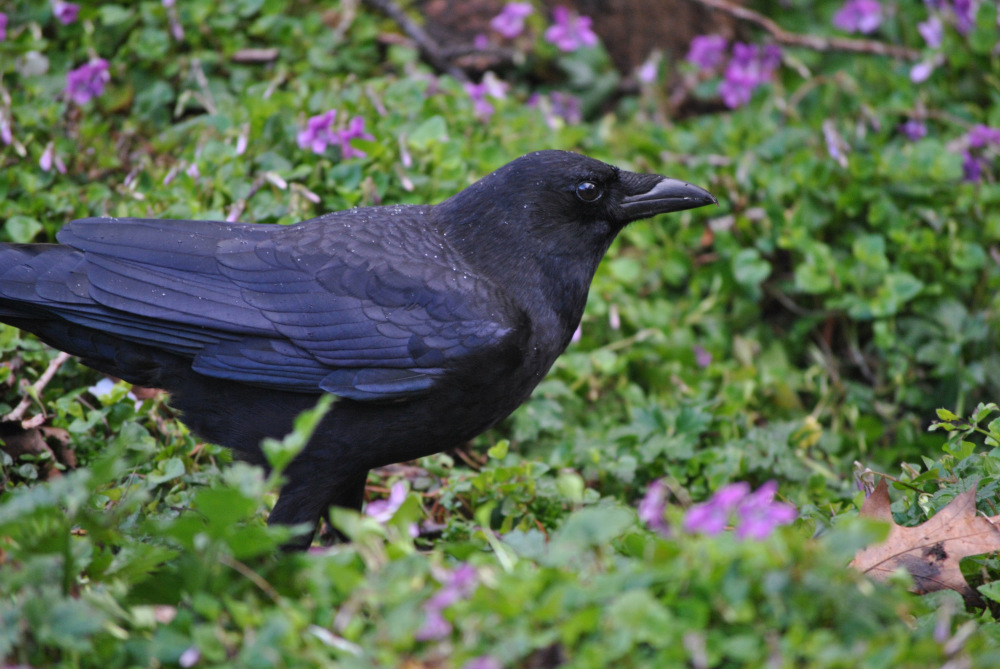
After one study ended, Swift and a crow named "Go" struck up a friendship. "I adored her, I wanted to know and understand everything I could about her," Swift writes. Photo: Kaeli Swift.
They struck up a friendship. "I adored her, I wanted to know and understand everything I could about her," Swift writes, "and I wanted to be part of the community that was using science to enhance people's appreciation for corvids. She wanted peanuts."
It was Go who first spotted Swift at the bus stop after the experiment was over. On her blog, Swift writes: "while waiting for the bus I heard the familiar rattle of her bands and turned to see her looking expectantly down at me from a branch. I offered her a peanut and she took it without pause. I never went to the bus stop without a few peanuts in my pocket after that. It's been four years since then." Swift writes of visiting the bird as many as two or three times a day during some stretches, especially when in need of an emotional lift while working to write up her research: "Hearing her wing beats was like taking a Xanax; it was calming and reminded me why I was working 15 hours a day juggling field work and authorship duties."
Throughout this fieldwork, Swift hasn't just gotten to know crows. She's gotten to know people too. Humans are always curious about crows, Swift reports, and they're curious too about crow researchers. That's worked out well.
Take, for instance, the time that a man in Seattle arrived home in his minivan only to discover Kaeli on the sidewalk snapping photos of his cedar-shingled roof. It was actually a crow on that roof that she was mesmerized by "the bird was flattened to the surface, wings spread, "bill agape," sunbathing.
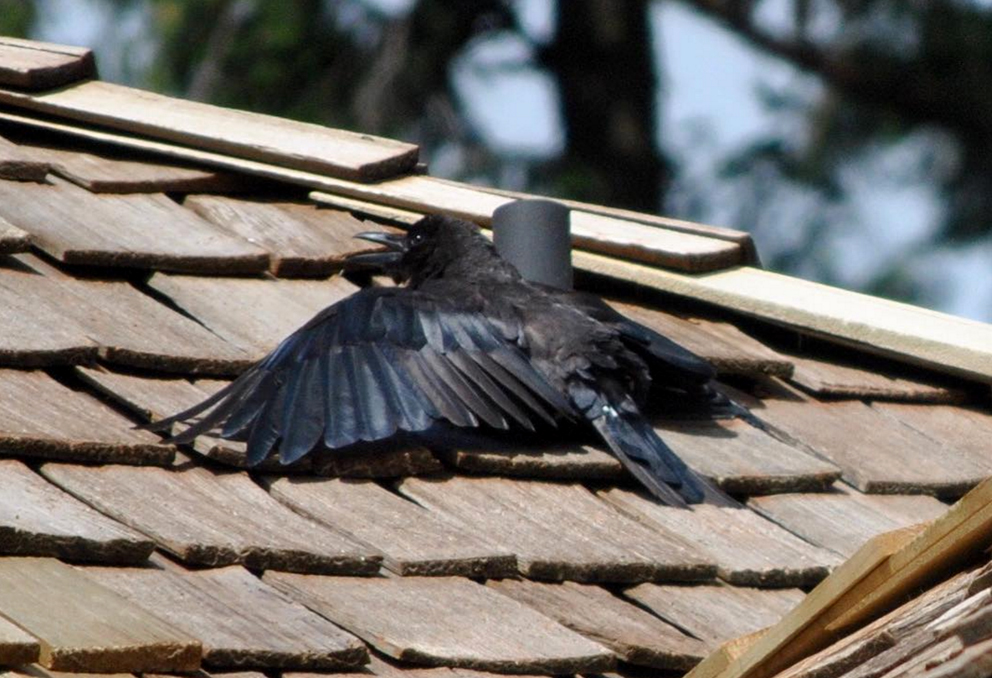
The "self-care regimen" of crows includes sunbathing. Photo: Kaeli Swift.
Swift was too absorbed in what might be misunderstood as an "admittedly creepy" task to hear the homeowner's car pull up. But the interaction ended well enough because of that crow-human connection. Swift told the rapt homeowner about why crows and other birds sunbathe "that it's largely a "self care regimen" that helps keep birds and their feathers healthy.
There are few aspects of crow life that don't catch Swift's notice. She's written on her blog about sightings and photos of light-colored American crows, parsing the scientific literature on the factors that control color, with the upshot: "this color abnormality presents a rather fascinating mystery of conflicting opinions and an overall dearth of science."
Later, in another blog, Swift reports seeing a light-colored American crow: "I FOUND A CARAMEL CROW! And not just a caramel crow, but a caramel crow with a mate and three fledglings. A black mate and three black fledglings. Which suggests that whatever is going on is either recessive or not genetic. It also shows that, for at least this one caramel bird, the color abnormality did not prohibit it from successfully reaching sexual maturity or finding a mate. After speaking with the neighbors, it appears ‘Blondie,' as they call it, has been in the neighborhood for several years and it's possible she's not the only caramel crow, though I never confirmed any others."
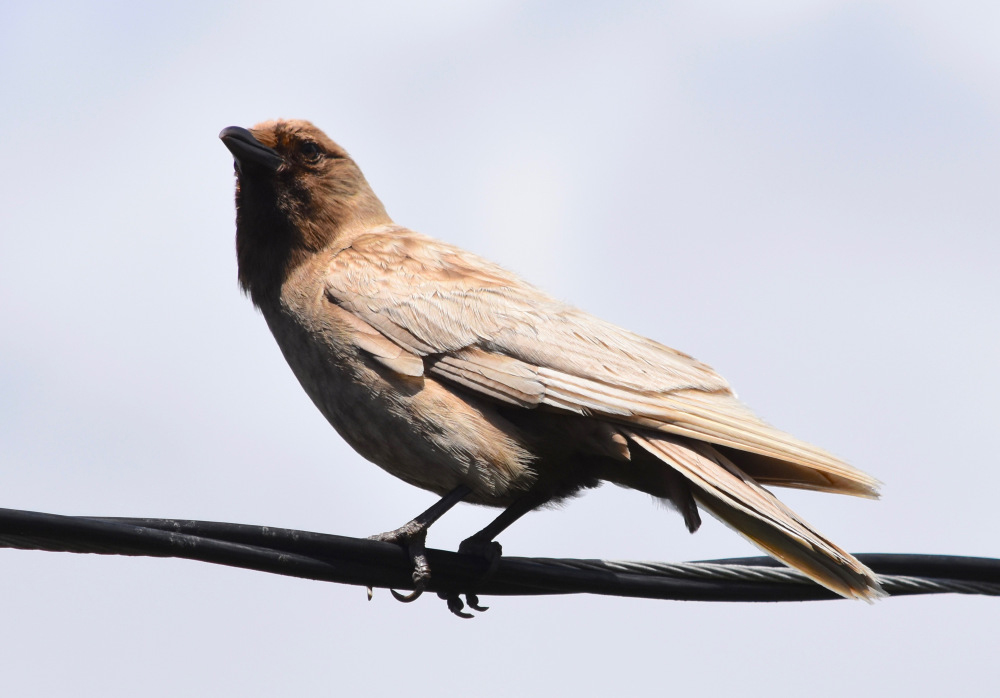
At first glance, and at a distance, researcher Kaeli Swift might have mistaken this bird (called "Blondie" by the people who live nearby) for a pigeon. Within seconds of the sighting, though, Swift realized she was seeing her first "caramel-colored crow." Swift says the color abnormality "presents a rather fascinating mystery of conflicting opinions and an overall dearth of science." Photo: Kaeli Swift.
Something in her research that doesn't require a lot of science to color code is a handful of Cheetos. Swift's explanation of why she uses them as well as peanuts to attract crows is simple: Not every crow likes peanuts. And beyond that, the "fluorescent orange" color of the Cheetos is visible from far away and crows seem to really, really like them "so the birds are motivated to come to the food pile every time.
The hardcore science "the stringent study of the "thanatology of crows" " is vitally important to Swift. But that isn't to say that she is unmoved by the lives and deaths of crows she has come to know. The two things aren't incompatible. Remember Go the crow? Go died last year from unknown causes, and Swift writes of learning of the wild bird's death.
"GO was at least 16 when she died. In that time she successfully raised many broods, contributed to two scientific publications, and undoubtedly befriended more people than just me. She embodied everything we love about crows: their deft skill at thriving among us, their bold demand of our time and attention, and the way they engender our curiosity and admiration. She was my data, inspiration, stress relief, and eager companion. I will never forget what this bird meant to me."

5 Responses to “Observing Crow ‘Funerals' And Plenty Of Lively Crow Life”
When I see, hear or talk about crows, I think of my laat supervisor. She called my name in a loud, shrill voice. I noted it sounded like a crow. “Carl! Carl!”
I once observed, in my back yard, a crow that was dying. It was making faint calls and soon several other crows gathered around. They were calling to the crow in turn and the dying crow would respond. It was amazing to see. They stayed with the crow until after it took its last breath, and remained there until it got dark. This was something I had never witnessed before and was quite moved by the involvement of the crow community. They seemed to be trying to comfort this dying crow.
We had a family of crows visiting our deck for about three years. They would bring their young and visit our side yard. There were some stones there and the parent would pick them up and toss them for the young, playing, we thought.
We would throw pizza crusts out on the deck and they would pick them up and let them soak in the bird bath we kept out there and then eat them. Some times, they brought things from other places and let them soak in the bird bath before eating. We so enjoyed them.
Wonderful sorry, thank you for sharing this great insight on crows and the fascinating ongoing research.
Crow Vending Machine on YouTube is another fantastic education on this smart bird
Comments are closed.